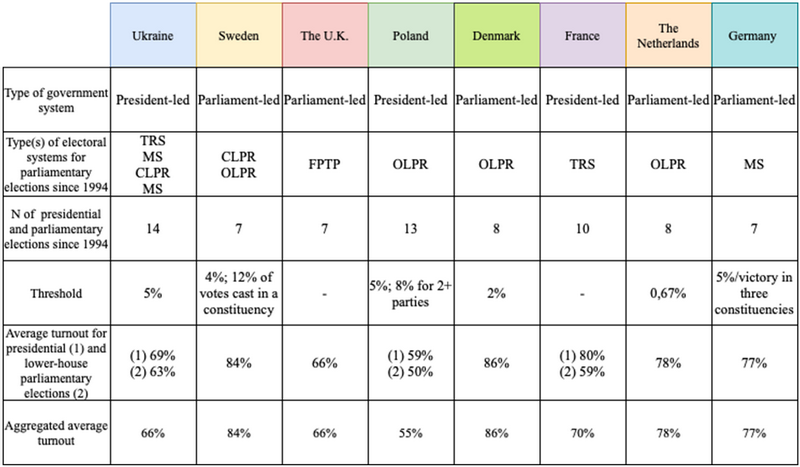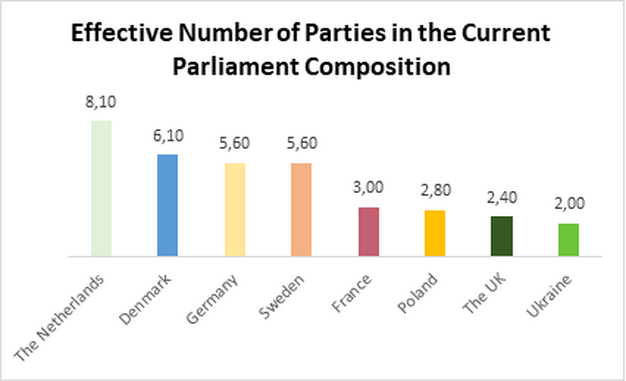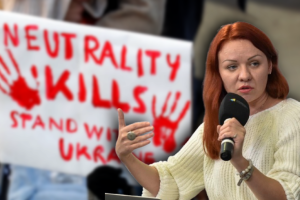 Lesia Dubenko, an analyst at 'Europe without Barriers'
Lesia Dubenko, an analyst at 'Europe without Barriers'
For every democratic country changing the electoral system design is a serious move with far-reaching consequences. Lesia Dubenko, an analyst at 'Europe without Barriers', discusses how the open list proportional electoral system could affect the Ukrainian political system.
As Ukraine marks its 29th independence anniversary, the country’s political landscape remains in the making. In late 2019, the Verkhovna Rada adopted several changes to the country’s Electoral Code, inter alia, replacing the mixed electoral system (MS) with the open list proportional representation one (OLPR) for both parliamentary and local elections—a reform advocated due to multiple factors. They include the dwindling voter turnout for parliamentary elections, a short lifespan of the parties as well as the pitfalls of MS, exemplified by the time former Ukrainian President Viktor Yanukovych re-introduced MS to get more purportedly independent candidates into the parliament that subsequently aligned with the “Party of Regions.”
With the first OLPR-powered elections set for October 25th, 2020, Ukraine is embarking on a new path that is likely to bring about multiple changes and thus require to be heeded by both academia and the policymakers.
Consequently, the aim of this analytical article is twofold. Firstly, to discuss what these changes might be and why they might occur drawing on theoretical considerations and comparative analysis. Secondly, to suggest the ways of communicating the OLPR-associated potential impact, both benefits and pitfalls, to the wider public to increase the reform’s effectiveness.
To meet these objectives, the article has been structured in the following way:
- Part 1 provides a brief overview of the theoretical debate about the electoral systems and their effects.
- Part 2 presents a comparative analysis of the eight countries, focusing on the link between electoral systems, turnout and effective number of parties and argues what the latter means for the parliament’s functioning.
- Part 3 suggests the best way to communicate potential OLPR-related impact to the wider public to maximize their benefits and avoid pitfalls.
The article is concluded by final remarks and a reference list.
Part 1
Why are electoral systems important?
For an uninitiated observer, the notion of electoral systems and their effects is, arguably, a complex one. Described as “the cogs that keep the wheels of democracy properly functioning” (Farrell, 2011, p. 2), in essence, electoral systems are a method of translating votes into seats.
The term encompasses a broad scope of issues, particularly who is eligible to partake in the elections (parties, candidates or both); what are the criteria for participation and victory (threshold, method of seat allocation, etc); how districts are formed and what magnitude they have (how many people will represent it). All these details, technical at a glance, have a considerable impact on a wide array of factors, including but not limited to:
- What will the parliament look like: will it be more fractured or more homogenous?
- Who will lead the country: the executive or the legislative branch, or both?
- How many parties will dominate in the parliament: two like in the U.K. or there will be no dominant actor like in Belgium?
The Conservative-Labor dominance observed in the U.K. and the U.S. is often attributed to the effects of the first-past-the-post system (FPTP), the simplest version of the majoritarian systems. This proposition is embedded in Duverger's law (see Duverger, 1951). |
In a decades-long debate of which electoral system is the optimal one, the primary contention has revolved around the widely acknowledged representativeness-accountability trade-off (Carey and Hix, 2011). Those in favor of proportional systems argue that while the majoritarian systems produce strong, accountable one-party governments and foster a direct link between voters and constituency candidates, are neither inclusive nor representative as the majority of ballots cast for non-dominant parties are effectively wasted. For this reason, Arend Lijphart has described proportionality as “virtually synonymous with electoral justice” (Lijphart, 1984, p.140).
The other part of the debate questions how the consequences of this trade-off affect voter satisfaction (see, for example, Farrell and McAllister, 2006) and turnout as well as the candidates, parties, etc. Previous research (see, for example, Norris, 2004; Robbins, 2010) suggested that on average proportional systems tend to foster greater turnout. The proponents of proportionality argue that this occurs because the proportional method of distributing votes helps to overcome the problem of wasted votes (FairVote, 2020), associated with MS and FPTP. Besides, unlike majoritarian systems, consensus democracies and PR electoral systems focus on the inclusion of all voices, emphasizing the need for bargaining and compromise within parliament, government, and the policymaking process (Norris, 2004, p.50).
While not everyone agrees, proportional systems or systems with a proportional element like Mixed Systems, employed in Germany and until recently in Ukraine, seem to have greater support among policymakers, particularly, in Europe. Thus 21 out of 28 countries in the European Union use some form of a proportional system; the elections to the European Parliament are held under the proportional system in all EU member states[1].
Part 2
OLPR and turnout: a glimpse of hope?
Having discussed the crux of the theoretical debate on electoral systems, the paper proceeds to its practical part. Drawing on a comparative analysis of eight countries, it will discuss the potential impact of OLPR’s introduction in Ukraine. The comparison will be first made in terms of turnout, which is seen as an indicator of the health of a democracy (Wagner, Johann and Kritzinger, 2012, p. 372).
Before proceeding, however, two considerations should be taken into account. First, as Peters (2013:38) underscores, it is difficult to attend any academic meeting on comparative politics without hearing at least once the phrase, “But those cases really are not comparable.” Alas, this comparative analysis is no different: Since 1991 Ukraine has changed its electoral systems four times, its version of the Mixed System differs from the one used in Germany[2] that has been included in the study, had the largest number of elections, and is qualified as partly free by Freedom House[3]. All the other countries, except Sweden, have used the same form of electoral systems for decades and are classified as fully free by Freedom House in all respects. Whilst this consideration should be kept in mind, it should also be noted that the majority of elections in Ukraine have been dubbed free by international observers such as the Organization for Security and Cooperation in Europe—a factor that somewhat mitigates the variation in comparison.
Second, since this is a non-probability comparative study limited in time (1994-2020) and space (countries located in Europe) and simplified country-specific reality, it should be precisely perceived as such. It does not entail any definite inferences while the claims based on it are in no way to be viewed as dogmatic. They are merely working hypotheses and are subject to subsequent discussion, debate, review, confirmation and disconfirmation as the number of countries and elections under scrutiny increases. At this stage, however, countries like Portugal and Greece that also use proportional systems have been omitted from the study as the former uses the closed-list proportional system while the latter has compulsory voting.
With these considerations in mind, let’s examine Table 1 that provides a comparison of eight countries with non-compulsory voting. Four of them use MS (Ukraine, Germany) and majoritarian systems (France, the U.K.), while the other four employ OLPR (Denmark, the Netherlands, Sweden, Poland)[4]. The table factors in the key variables that pertain to the general set-up of the country such as type of government system[5] as well its election scene, namely types of electoral systems[6], number of elections held (presidential and lower-house parliamentary elections), electoral threshold, and the aggregated average turnout[7] (see Table 1).

Table 1 A comparison of Ukraine, Sweden, The U.K., Poland, Denmark, France, The Netherlands, Germany
Acknowledging the country-specific differences capable of influencing the turnout and the fact that it is based on a limited number of cases[8], data from Table 1 nonetheless indicates that, except for Poland and Ukraine, countries that use a fully or semi-proportional systems, have higher aggregated average turnout, compared to those using majoritarian (see Table 2). This plays into the theoretical assumption that proportionality leads to a higher turnout. The fact that all four countries with the highest values have had a similar number of elections and score 95+ out of 100 points, as per Freedom House, further strengthens the claim.

Table 2 Aggregated Average Turnout 1994-2020
One potential reason why this is the case pertains to the above-discussed factors,
particularly that the proportional method of distributing votes helps overcome the problem of wasted votes. If this is so, then Ukraine, where the turnout has decreased substantially since 1994 (in 1994 the number stood at 78%; in 2019 it decreased to 49.2%), might well benefit from OLPR’s implementation. In the 2014 parliamentary elections, for example, 43% of the casted votes were effectively wasted (Betliy et al, 2019). Given that under a fully proportional system, the number would have been 22% (Betliy et al, 2019), this might suggest that over time and upon the condition of recurrence, the system might help the voters realize that their votes are likelier to make a bigger difference than under the MS system. And thus foster a higher level of turnout.
The other potential reason why turnout is higher under OLPR and semi-proportional German MS has to do with the reconceptualization of the party-candidate relations[9], which paves the way for intra-party competition (Blumenau, Eggers, Hangartner, Hix, 2014). Such a competition tends to reward candidates who have more local background and experience (Betliy et al, 2019) while preserving one of the biggest advantages of the majoritarian systems, i.e. fostering the direct link between a candidate and a voter. In light of the close-to-completed decentralization reform in Ukraine, OLPR’s potential to increase turnout in Ukraine seems promising as the residents of the newly amalgamated communities will get the chance to send a greater number of local candidates into the parliament and thus have their interests better represented at both local and national level.
One other reason why the proportional system might be fostering turnout has to do with the system’s propensity to increase the effective number of parties (ENP)—an index introduced by Laakso and Taagepera (1979) that adjusts the parties’ relative strength—in the parliament and other representative bodies. For example, the UK’s House of Commons is made up of 9 parties (excluding the Irish Sinn Féin abstentionists), yet its ENP index stands at just 2,4 (see Table 3), meaning that effectively only two parties play a role in the government formation. The Swedish Riksdag, on the other hand, comprises fewer parties than the House of Commons (8 parties), however, its ENP index stands at 5,6, meaning that almost six actors are capable of engaging in coalition bargaining as well as influencing the vote.
The realization that the party s/he is supporting is likelier to have a stronger voice in the government formation process and legislative agenda could very well serve as an incentive for a voter to show up at the polling stations and could be one of the reasons why the Netherlands, Denmark, Sweden, and Germany, whose ENP indexes are 8,1, 6,1[10], 5,6 and 5,6 respectively, also have the highest aggregated average turnout. Given that the current ENP in Ukraine stands at 2 (between 2007-2019 it varied between 3,3-3,7), the fact that OLPR seems to increase the ENPs might provide Ukrainian voters with a greater incentive to cast a ballot during the elections.

Table 3 Effective Number of Parties in the Current Parliament Composition [11]
Increased bargaining complexity: On the road to a parliamentary republic?
Having discussed the reasons why there seems to be a higher turnout in countries that use OLPR (except for Poland), the paper now turns to discussing another important impact of the system. It pertains to the above-mentioned index of ENPs and its influence on the government’s functionality, particularly bargaining complexity, which “refers to the number of options and actors that are available to form a government” (Louwerse and Van Aelst, 2013, p.4).
On the one hand, a greater number of ENPs in the parliament is a positive development as it leads to the inclusion of a greater number of voices—a circumstance that may well appeal to voters who feel otherwise left out. Yet, it also has pitfalls of its own: Louwerse and Van Aelst (2013) note that in some countries, the increase of ENP that occurred between 2000-2013 goes “hand in hand with an increase in the length of coalition negotiations (Belgium, Sweden, Norway, Austria). In other countries, both ENP and the length of coalition negotiations decreased (France, Malta)” (p.6).
While seven years have passed since the publication was made, there are grounds to believe that the situation has remained intact. The 2018-2019 coalition talks in Sweden, for example, took more than 5 months to complete and resulted in the rule of a minority government, now dubbed “the norm” (Bäck, Hellström, Lindahl, 2020). In Belgium[12], another country that uses OLPR with a 5% threshold, at the time of writing the coalition talks exceeded 600 days (in 2010-2011 it took the country 541 days to form a government).
Assuming there is a connection between OLPR, a greater number of ENPs and bargaining complexity, a natural question arises: is such a scenario possible in Ukraine, the ENP index of which currently stands at 2?
The answer is likely to be yes both since the fact that Table 3 shows that all countries that use OLPR (except for Poland) have higher ENP indexes and Ukraine’s own experience: in 2006-2007, Ukraine used a fully proportional electoral system with closed party lists and back then the ENP index was higher, 3,3.
While it does not necessarily mean that Ukraine will immediately end up with an ENP index of 9,7 like in Belgium or that it will take years to form a government, the possibility of an increased bargaining complexity as a result of a greater ENPs seems to be plausible. More so if following the local elections set for October 25th, the local representative bodies will end up with a higher ENP index than under the MS system.
Accordingly, it is likely that Ukrainian politicians will eventually realize the need to alternate their modus operandi and seek consensus at both the pre-election and post-election stage as it will no longer be as feasible to produce one-two party coalitions and experience blitzkrieg-style electoral triumph. Given that Ukraine is a president-led system with a high dependence on personas, embedded societal polarization and strong levels of populism in election campaigns, which Louwerse and Van Aelst also link to the concept of bargaining complexity, the consensus-seeking process within the Ukrainian parliament is likely to result in lengthier deliberations to form a basic coalition of 226 MPs.
Besides, the stronger role of parliamentarian parties in the government formation process and political influence might resurrect the long-standing Ukrainian problem known as the duality of power (see, for example, Imanberdiev, 2015) or co-habitation, exemplified by the political wars between former Ukraine’s President Viktor Yushenko and PM Yulia Tymoshenko. Since Ukraine’s political landscape remains persona-centered, oligarch-backed, susceptible to personal feuds, the increased bargaining complexity resulting from a higher number of ENPs might effectively put the president in limbo. The longer it takes for the parties to form a coalition, put forward the PM candidate and appoint a government, the harder it will be for the president to swiftly implement her agenda. And the more difficult it will be to hold someone accountable for the overall failures and success (speaking of the representation-accountability trade-off).
These prospects might eventually force Ukraine to beg the question of where it is going in the long-term and who will lead the process, resurrecting the discussion on the need to transform Ukraine into a full-fledged parliamentary republic (see, for example, Umland, 2010). Aside from the problems that co-habitation entails, the anticipated argument[13] in favor of this transformation is that compared to consensual democracies presidential systems tend to polarize society (see, for example, Smith and Setlzer, 2015; Cameron, 2002), dividing Ukraine along the trite yet effective lines of “pro-Russian” and “pro-Western”, “pro-nationalist” and “Ukraine-phobic”. While it is worth noting that the incumbent President Volodymyr Zelenskiy secured 73% of the votes in the second round of the 2019 presidential elections, the instance is, arguably, an exception, not a rule.
Yet while the likelihood of an increased bargaining complexity as well as the associated power struggle is conceivable, it nonetheless requires a separate detailed analysis for two reasons. First, because Table 3 shows that in Poland, which is a president-led political system like Ukraine, the ENP index is only slightly higher than in the U.K., meaning that OLPR does not automatically lead to a higher effective number of parties and increased bargaining complexity.
Second, even though in 2014 the Verkhovna Rada included 3,7 ENPs, the parties managed to create a broad coalition within a reasonable timespan. Thus Ukraine has the experience of fostering consensus.
Part 3
Escaping the pundit circle
Having discussed what changes OLPR is capable of bringing about as well as why, this paper now proceeds to its second aim: suggest the ways of communicating the OLPR-associated potential impact, both benefits and pitfalls, to the wider public to increase the reform’s effectiveness.
In the sections above, it was propounded that there are grounds to believe that Ukraine might benefit from the changes that OLPR is likely to entail. Yet, it was also noted that it was being compared to the countries with a more established electoral scene that are deemed substantially more democratic in all respects. Precisely because of this, the relevant stakeholders need to pay gargantuan attention to how they communicate the reform to the wider public. After all, the mere alternation of electoral systems, whilst leading to some institutional changes, is not a universal remedy that automatically and indisputably leads to a higher turnout, a more consensual democracy as well as a general level of content. All it does is create opportunities that first need to be understood by the general public, for example, by initiating a user-friendly, jargon-free educative campaign revolving around three main themes:
- How OLPR increases the weight of your vote compared to MS
- How OLPR might help to tackle local problems at the national level by increasing intra-party competition and rewarding a larger number of candidates with local background
- how OLPR fosters consensual democracies by empowering a greater number of parties in the parliament, inter alia, during the coalition-building process whilst also being honest as to how it may affect the duration of the talks and the coalition’s effectiveness
That said, a special focus in the communication campaign, which should be commenced as quickly as possible, should be placed on those voters who have so far abstained from attending the polling station as they are the primary target group of this reform, not the ones already voting. Ideally, it should also be complemented by the introduction of a series of specialized studies like the British Election Study[14],
Concurrently, the communication channels should be chosen depending on their likelihood to reach the desired target audience, which in this case is, unequivocally, the youth. In 2019, the late Head of Ilko Kucheriv “Democratic Initiatives” Foundation, Iryna Bekeshkina, revealed that just 27% of young Ukrainians attended the polling station[15] during the snap parliamentary elections.
The media plays an important role in stimulating voters and explaining the alternation of systems as exemplified by the case of France and the U.K. An analysis of 151 articles (Dubenko, 2017) produced by the leading media outlets in both countries before the European Parliament elections, considered second order[16] (Reif and Schmitt, 1980), showed that at least 13 articles were devoted to a detailed explanation of how proportional electoral systems differ compared to the ones used for national parliamentary elections and why it is important to vote. It is highly advisable that Ukrainian media, especially at the local level, assume the same role. |
At the same time, since OLPR is likely to increase the ENPs, it is also highly important that the other part of the campaign focuses on the interaction with parties and prospective candidates standing for election. They should be ready that:
- OLPR’s design requires greater coordination among parties at both pre-election and post-election stage
- The need for compromises will be higher
- The responsibility will become greater
After all, Ukraine, unlike other countries mentioned in the comparison, has an ongoing war with Russia and an economic turmoil to fix. It therefore cannot afford to be placed in limbo.
Final remarks
To sum up, the OLPR’s potential impact on Ukrainian political landscape stands as follows:
- The system has the potential to increase voter turnout as it mitigates the problem of wasted votes while preserving the direct link between the voter and the candidate
- It could lead to the increase of ENPs in the parliament, intensifying bargaining complexity and enhancing the role of the Parliament in the country’s governance
- It could make it harder for the president to swiftly implement her agenda
While these conclusions, as well as the assumptions underpinning them, are by no means to be viewed as dogmatic and require refinement through subsequent research, factoring in more countries and variables, they do nonetheless generate a lot of food for thought.
Undoubtedly, ameliorating the general unscrupulousness of Ukraine’s political landscape is a difficult endeavor. However, there are grounds to believe that the introduction of OLPR has the potential to disrupt the malicious patterns, improving the link between voters and their representatives and paving the way for a more consensual democracy. In this regard, it is paramount that leading non-governmental organizations in Ukraine, foremost the International Foundation for Electoral Systems and OPORA that have been working on the amendment of Ukraine’s Electoral Code, continue to cooperate with Ukrainian officials in the years to come. This cooperation should revolve around the analysis of OLPR’s effects on the Ukrainian political landscape, particularly, the factors analyzed above as well as the communication of the system’s advantages and pitfalls.
Combined, these efforts will arguably help Ukraine take steps toward a healthier democracy. Even if those steps are baby ones.
Reference List
Blumenau, J., Eggers, A., Hangartner, D. and Hix, S., 2016. Open/Closed List and Party Choice: Experimental Evidence from the UK. British Journal of Political Science, 47(4), pp.809-827.
Cameron, C., 2002. Studying the Polarized Presidency. Presidential Studies Quarterly, 32(4), pp.647-663.
Carey, J. and Hix, S., 2011. The Electoral Sweet Spot: Low-Magnitude Proportional Electoral Systems. American Journal of Political Science, 55(2), pp.383-397.
Dubenko, L., 2017. The Discreet Charm of (Not) Casting a Vote A study of an effect of election campaigns on turnout for the Legislative Elections in France in 2012, the General Elections in the United Kingdom in 2015 and the European Parliament 2014 Elections in both countries. Available at: https://lup.lub.lu.se/student-papers/search/publication/8907597 [Accessed 30 June 2020].
Duverger, Maurice. 1951 1964. Political Parties: Their Organization and Activity in the Modern State. 2nd ed. London : Routledge.
FairVote. 2020. Proportional Representation Voting Systems - Fairvote. [online] Available at: [Accessed 9 July 2020].
Farrell, D. (2011). Electoral systems. 1st ed. Basingstoke: Palgrave Macmillan.
Farrell, D. and McAllister, I., 2006. Voter satisfaction and electoral systems: Does preferential voting in candidate-centred systems make a difference?. European Journal of Political Research, 45(5), pp.723-749.
Imanberdiev, D., 2015. Dualism Executive Power in Ukraine: The Nature and Ways to Overcome. Visnyk NAPA, [online] (4), pp.47-54. Available at: [Accessed 9 July 2020].
Laakso, M. and Taagepera, R., 1979. “Effective” Number of Parties. Comparative Political Studies, 12(1), pp.3-27.
Lijphart, Arend. 1984. Democracies: Patterns of Majoritarian and Consensus Government in Twenty‐One Countries. New Haven , CT : Yale University Press.
Louwerse, T. and Van Aelst, P., 2013. The exceptional Belgian case? Government formation processes in comparative perspective. [online] Available at: [Accessed 19 August 2020].
Norris, P. (2004). Electoral engineering. 1st ed. Cambridge: Cambridge University Press.
VoxUkraine. 2020. On Behalf Of The People. Ukraine Requires Electoral System Reform. [online] Available at: [Accessed 30 June 2020].
Reif, K. and Schmitt, H. (1980) Nine Second-Order National Elections-A Conceptual Framework for the Analysis of European Election Results. European Journal of Political Research, 8(1), pp.3-44.
Robbins, J., 2010. The personal vote and voter turnout. Electoral Studies, 29(4), pp.661-672.
Smith, R. and Seltzer, R., 2015. Polarization and The Presidency. Boulder, Colo.: Lynne Rienner.
Wagner, M., Johann, D. and Kritzinger, S., 2012. Voting at 16: Turnout and the quality of vote choice. Electoral Studies, 31(2), pp.372-383.
Umland, A., 2010. What Political System Does Ukraine Need? From Presidentialism to Parliamentarianism. [online] Available at: [Accessed 8 July 2020
This analytical material was presented by the Ilko Kucheriv Democratic Initiatives Foundation as part of its project implemented under the USAID/ENGAGE activity, which is funded by the United States Agency for International Development (USAID) and implemented by Pact. The contents of this analytical material are the sole responsibility of Pact and its implementing partners and do not necessary reflect the views of USAID or the United States Government.
[1] Countries that use majoritarian systems for their national elections like France and until recently the U.K. have been alternating their systems for the EP elections, switching from first-past-the-post and two-round system to a proportional one.
[2] Germany has a much more complex system of distributing the seats in the Parliament that aims to level the discrepancies between the parties and thus produce a more proportional outcome.
[3] https://freedomhouse.org/country/ukraine/freedom-world/2020
[4]Calculations are based on data and information retrieved from The International Institute for Democracy and Electoral Assistance’s voter turnout database and the International Parliamentary Union. Note that none of the countries were chosen deliberately, however, Belgium was excluded from the study due to the fact that it has compulsory voting.
[5] Note that for this analysis the author decided to use the terms parliament- and president-led as the more classical terms like semi-presidential and parliamentary to make the analysis and claims clearer for the reader.
[6] TRS: Two-round majoritarian system, CLPR: Closed-list proportional system.
[7] Aggregated average turnout is the mean of the average turnout for president and lower house parliamentary elections.
[8] To be able to reach a more definite conclusion, more countries and more elections should be examined in subsequent studies alongside the analysis of such factors as district magnitude, electoral formulae, etc.
[9] As per the new Electoral Code, the candidates are obliged to be party-affiliated.
[10] You might rightly note that one of the reasons why the ENP in these two countries is high is because of a low threshold, yet before you jump to any definite conclusions keep in mind that Belgium’s ENP index despite an electoral threshold of 5% stands at 9,7.
[11] The data for all countries except Ukraine has been retrieved from http://www.parlgov.org. In order to produce the ENP index for four parliament compositions, the author used the  , where vi denotes the share of the votes going to each party i, and the notation above and below the summation sign shows that it covers all parties from the largest (V1) to the smallest (Vx). All four calculations are based on the seats that a party has in the parliament, encompassing MPs elected with both types of systems. In the case of 2019 elections, the following data, available on the Parliament’s site, was taken into account: The Servant of People (248), Opposition platform Pro-Life (44), Bat’kivshyna (24), European Solidarity (27), Golos (19).
, where vi denotes the share of the votes going to each party i, and the notation above and below the summation sign shows that it covers all parties from the largest (V1) to the smallest (Vx). All four calculations are based on the seats that a party has in the parliament, encompassing MPs elected with both types of systems. In the case of 2019 elections, the following data, available on the Parliament’s site, was taken into account: The Servant of People (248), Opposition platform Pro-Life (44), Bat’kivshyna (24), European Solidarity (27), Golos (19).
[12] It has not been included in the comparison because it has compulsory voting.
[13] The author views this matter and the debate ensuing from it, through the lens of the modernist and post-modernist view of country-building, namely whether Ukraine is still adhering to the need of constructing a strong, nationalist state or whether it moves into a post-modern realm, championed by the European Union. Further discussion of the matter would go beyond the scope of this paper.
[14] One of the reasons why it is difficult to carry out research and comparative analysis that includes Ukraine has to do with the scarcity of data that is often scattered as well. This circumstance substantially complicates the attempts to carry out research and make data-driven decisions.
[15] https://uatv.ua/na-parlamentskyh-vyborah-progolosuvaly-lyshe-27-molodi-tsentr-razumkova/
[16] While the second-order framework is usually applied to the analysis of European Parliament elections, it could be argued that in semi-presidential government systems parliamentary elections are also second-order as they are considered less important compared to presidential elections. This is, inter alia, visible from the turnout data available in Table 1 that shows that the average turnout for presidential elections is higher compared to parliamentary ones.








